Senior curator Kirstie Ross says Computer Cat is one of her favourite items from the collection. (ABC News: Luke Bowden). Click here to view video.
Luke Bowden, Covers off the Tasmanian Museum and Art Gallery’s hidden treasures that don’t often see the light of day, ABC News, 26 March 2023
What do a delicate feather, a tiny gold-encrusted snail, a furry feline puppet, and a jar of giant sea spiders have in common?
Key points:
- The Tasmanian Museum and Art Gallery’s storage and collection facility holds millions of often unseen items
- They include strange creatures, historical artefacts and props from TV favourites
- Curators see themselves as the “current custodians” of the collections
They are just a handful of the millions of items curated and cared for at the Tasmania Museum and Art Gallery’s (TMAG) Collection and Research Facility.
In a large room of stuffed animals, senior curator of zoology Cathy Byrne holds a box containing a single dark feather — the only one of its kind in Australia.
“What I have is a very interesting specimen from an emu that became extinct on King Island in the early 1800s,” she said.
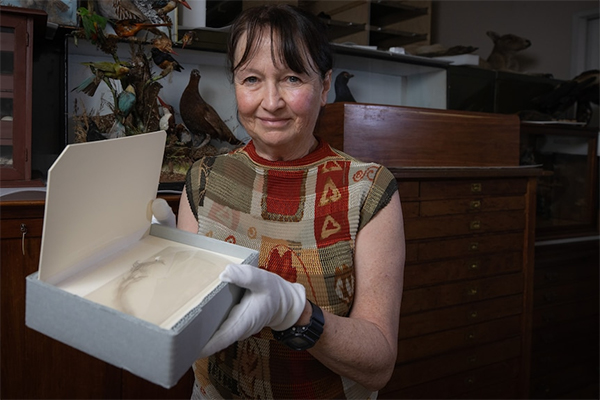
The feather was given to TMAG by the Paris Museum of Natural History in 2000.
The King Island Emu was a subspecies of the mainland Australian Emu, eaten into extinction in 1805 by sealers and whalers.
TMAG’s feather is from an emu that died in 1822 in, of all places, Paris.
French explorer Nicolas Baudin circumnavigated Australia between 1800-1803, collecting many live specimens, including three emus from King Island in 1802.
They survived the voyage back to France, housed in the officer’s cabins, dining on cake and wine — a lavish lifestyle that continued after their arrival, Dr Byrne said.
“They were given to the Empress Josephine, who was the wife of Napoleon Bonaparte at the time, and Josephine had an amazing garden that was stocked with exotic animals from all over the world at a place called Malmaison.”
Dr Byrne said historical records suggested the birds thrived.
“They survived there until 1822, so, amazingly, those birds actually out-survived the species in the wild.”
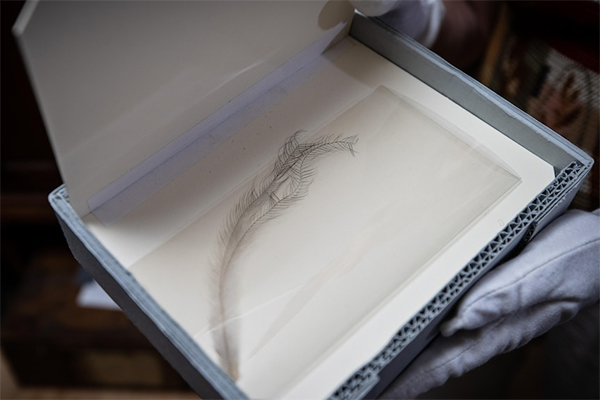
The zoologist pointed to a research paper from the University of Tasmania earlier this year that Tasmanians might once again share their island with the iconic Australian bird.
“It proposed that we rewild Tasmania, and that’s an interesting proposition. Because often, when you do reintroduce animals that have become extinct, it does a lot of beneficial things for the ecosystems.
“So, you never know, one day we might have emus in Tasmania again.”
From the old to the more recent
TMAG’s cultural heritage collection, managed by Kirstie Ross, features old and new items.
Some of them tell the story of Tasmania’s film and TV industry.
“We’ve got a really huge collection of props from the Rosehaven series that I’m trying desperately to pick out the iconic items from, because it was a really significant production here and really captures Tassie life,” she said.
A prop from a much older ABC TV show also filmed in Tasmania is one of Ms Ross’s favourites — Computer Cat from the TV show Hunter.
Ms Ross delicately lifts the slightly scary furry feline puppet from its shelf in the collection.
“CC, as she was known, was operated by Noreen Le Mottee, and she and Phillip Sabine (who played the main character Hunter) both thought that Computer Cat was a bit of a bossy britches, a bit of a know-it-all actually … I guess she had a computer, so she had all that information at her fingertips.”
Le Mottee, well known in Tasmania’s theatre society, had previously done a little puppeteering but nothing like quite becoming CC.
“I discovered muscles I didn’t know I owned,” she said.
“I would spend my day underneath a desk with my hand up a puppet, a microphone at my face, the script on my knee and a TV monitor at my feet so I could see where my hand was supposed to be.”
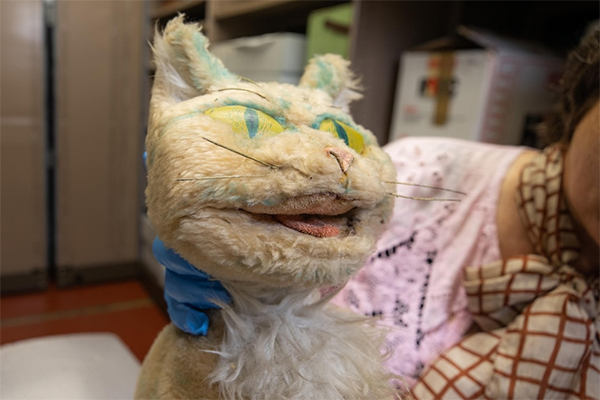
Ms Le Mottee and Mr Sabine donated CC to TMAG’s cultural heritage collection in 2012, something the thespian is extremely proud of.
“I’ve had so many people who have told me what Hunter meant to them as kids, and it suddenly had a whole new meaning to me,” she said.
“It was astonishing to realise that so many children loved this program and Computer Cat to boot!”
Dr Simon Grove looks after Tasmanian invertebrates housed in the collection, with one named in honour of world-famous documentary maker Sir David Attenborough.
“This is from a pretty special snail,” said Dr Grove, showing off a tiny gold-encrusted shell, “because its entire global distribution is just half of the Tasman Peninsula and adjacent Forestier Peninsula”.
Commonly, they are called burgundy snails due to the colour of their body, which is so big it does not fit inside their shell, making them what’s known as a semi-slug.

The specimen was sent to the Australian Museum in 2017 when curators suspected it did not belong to the genus to which it had been assigned (Helicarion rubicundus).
They spotted the specimen in gold so they could use a scanning electron micrograph to look at the walls of the shell and discovered it was part of a new genus.
“So to honour Sir David [Attenborough], who was visiting the Australian Museum at the time, they decided to create a new genus called Attenborougharion rubicundus,” he said.
Dr Grove believes it is a good example of museums working together.
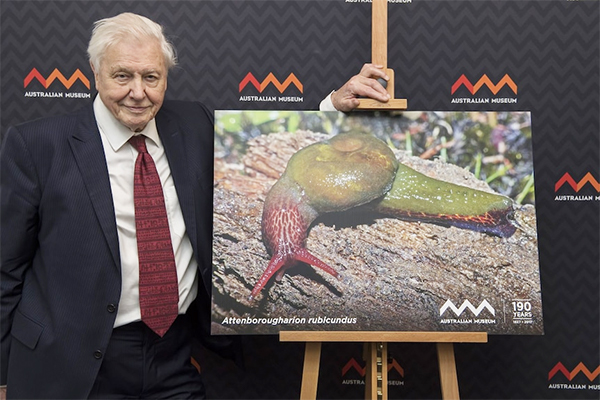
“It’s really gratifying to see our specimens used that way because we hold nearly all the specimens of this species.
“So to be able to share the material and then for them to share the knowledge back in return is just the way collaborations should work in science.”

Strange deep-sea giants
The facility also has a special wet storage area containing Tasmanian deep-water specimens preserved in ethanol.
“We’ve got these giant sea spiders … they’re normally tiny,” said collection manager Dr Kirrily Moore.
“Around Tasmanian waters in the shallows when you find them, they’ll only be a couple of centimetres across, but in deep water [200m and below], they can be 30-40 centimetres.”
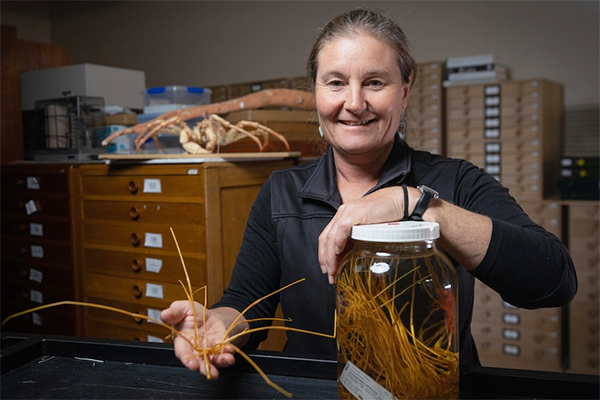
Dr Moore describes the giant spiders as “fantastic predators”, pointing to the specimen’s proboscis — the large protruding mouth.
“It will go towards an anemone and use its proboscis to suck out the middle of it.”
And ironically, they’re not actually spiders.
“We’ve worked out they’re not related to spiders at all. They’re more of a crustacean than a spider, but they’re not that either; they’re sort of their own group.”

Doctor Moore describes herself as the “current custodian” of the collection she manages.
“The collections existed before we got here and will keep going after us,” she said.
“You’re looking after it for your lifetime, and then you move on. It’s not your collection; it’s the state collection. So it belongs to everyone.”

